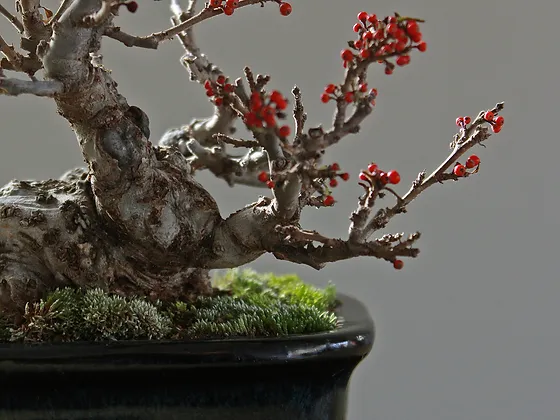On this page, you’ll find 7 handy hints and tips from Way of Life Bonsai for caring for Japanese Winterberry Bonsai.
Don’t forget to check out our tools and essential items, access advice and guidance from our experts, and check out our other specimen, beginner and Outlet trees.

Caring for Japanese Winterberry Bonsai: The Japanese Winterberry is an outdoor plant and should be placed outside all year round. The male and female trees must be placed very near to each other to make sure they have the same growing conditions, especially in spring, so that both genders will flower at the same time.
The Winterberry needs a lot of sunlight for producing its fruit, but should be protected from intense heat and sun during the hottest summer days. Birds like the berries and steal them as soon they begin to turn red. So you have to protect the trees, maybe in some kind of birdcage, if you want to enjoy the beautiful sight of the red fruits on bare twigs in autumn and winter.
The Japanese Winterberry tolerates frost but should be protected from very low temperatures when it is planted in a bonsai pot.
Caring for Japanese Winterberry Bonsai: Don’t let the Winterberry dry out completely. Water it thoroughly as soon as the soil surface gets dry.
Caring for Japanese Winterberry Bonsai: Use a balanced liquid fertilizer once a week during the growing season. You can also apply solid organic fertilizer.
Caring for Japanese Winterberry Bonsai: New shoots are cut back leaving two leaves after four leaves have developed. Do not defoliate the Japanese Winterberry completely because it needs the leaves for producing energy for the fruit. Wiring is best done from autumn to spring because the leaves come off at a light touch when you try to wire twigs with foliage.
Caring for Japanese Winterberry Bonsai: Repot every second year in spring with root-pruning. A suitable soil mix is Akadama, pumice and a little humus.
Propagation: The Japanese Winterberry can be propagated from seeds and cuttings.
Caring for Japanese Winterberry Bonsai: In spring aphids sometimes attack the Japanese Winterberry. They are easy to control with specific insecticides.
Japanese Winterberry: A Vibrant Splash of Winter Elegance
The Japanese Winterberry, scientifically known as Ilex serrata, is a captivating deciduous holly species that emerges as a beacon of color and vitality during the winter months. Renowned for its vibrant berries and distinctive serrated leaves, this shrub not only adds a splash of elegance to winter landscapes but also provides essential nourishment for wildlife.
1. Striking Berries and Foliage:
The Japanese Winterberry steals the winter spotlight with its striking red berries that persist throughout the coldest months. These glossy orbs, often clustered along the stems, create a vivid contrast against the shrub’s serrated, dark green leaves. The combination of the lustrous berries and unique foliage makes the Japanese Winterberry a standout feature in winter gardens.
2. Winter Interest and Color:
In the midst of winter’s muted tones, the Japanese Winterberry brings a burst of color to the landscape. The persistent berries, which are actually drupes, remain on the branches long after the leaves have fallen, transforming the shrub into a living sculpture. The red berries serve as a visual feast for the eyes, creating a picturesque scene against the backdrop of snow or dormant surroundings.
3. Wildlife Sanctuary:
Beyond its ornamental appeal, the Japanese Winterberry plays a crucial role in supporting wildlife during the harsh winter months. The berries are a valuable food source for birds, providing them with essential nutrition when other natural food supplies are scarce. This shrub becomes a focal point for birdwatchers, as various bird species flock to feast on its vibrant berries, turning the garden into a lively winter haven.
4. Adaptable and Hardy:
The Japanese Winterberry is appreciated not only for its visual allure but also for its adaptability and hardiness. Thriving in moist, well-drained soils, this deciduous holly is versatile in terms of growing conditions. It can tolerate a range of soil types and is well-suited for both sunny and partially shaded locations. Its resilience to winter cold and ability to withstand wet conditions make it a reliable choice for diverse garden settings.
5. Pruning for Structure:
While the natural form of the Japanese Winterberry is captivating, strategic pruning can enhance its structure and overall appearance. Pruning can be done to maintain a specific shape, remove dead or damaged branches, and promote optimal berry production. Proper care and occasional pruning contribute to the shrub’s health and longevity, ensuring it remains a vibrant presence in the winter landscape.
6. Landscape Design Element:
The Japanese Winterberry is not only a wildlife-friendly addition to gardens but also a versatile design element. Whether planted as a specimen shrub, incorporated into mixed borders, or used in mass plantings, its seasonal display elevates the aesthetic appeal of winter landscapes. The combination of its distinctive foliage, vibrant berries, and adaptability makes it an asset in various garden designs.
In conclusion, the Japanese Winterberry stands as a testament to the beauty and resilience of nature in the winter months. With its vibrant berries, distinctive foliage, and contributions to wildlife, this deciduous holly adds a touch of elegance to winter landscapes, transforming the garden into a visual spectacle and a haven for birds seeking sustenance in the colder season.
Web Design | Terms | Privacy